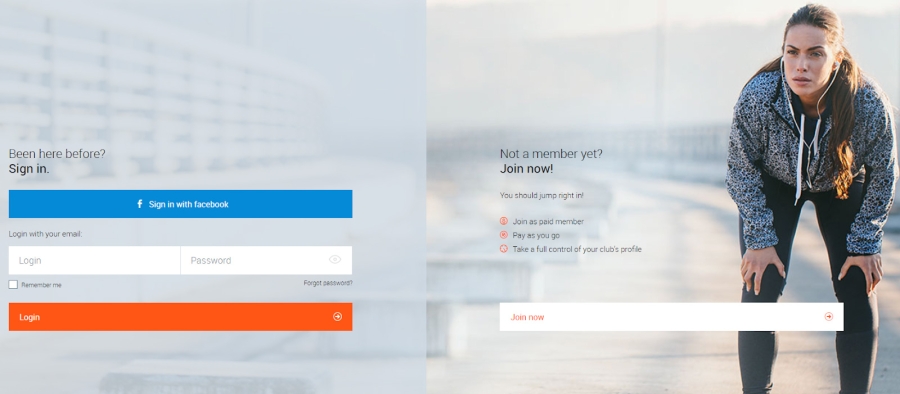
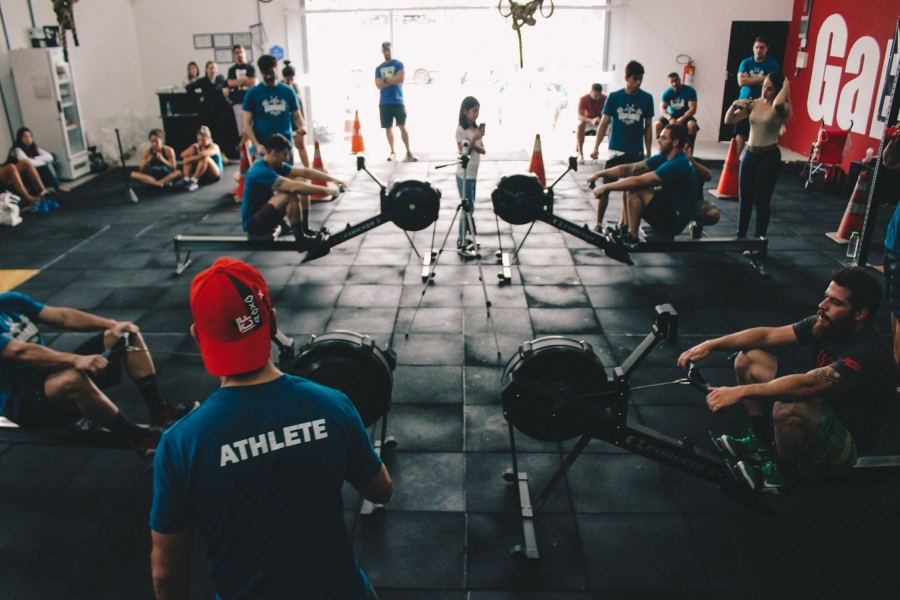
Whether you’re a small gym or a large chain of gyms, your fitness marketing strategy is one of the most important parts of running your business.
- simple to navigate
- informative about club location, hours, facilities, etc.
- present in the search engines
In some situations, word-of-mouth marketing can make up most of your member acquisition. However, in more competitive markets, word-of-mouth sometimes isn't enough.
“A small list that wants exactly what you’re offering is better than a bigger list that isn’t committed.” – says Ramsay Leimenstoll
A small list that wants exactly what you’re offering is better than a bigger list that isn’t committed. – says Ramsay Leimenstoll
Fitness clubs are local businesses, meaning that they have to compete in a very competitive local market for clients.
So how do fitness businesses' compete in such crowded markets?
Here we’ll go over 11 fitness marketing strategies and on how to promote your fitness facilities effectively to drive new customer acquisition.
1. Create a User-Friendly Website
It’s no secret that roughly 54% of people look online for a business as their first or second contact point. That’s over half of your potential audience!
This is where your website can help. In order to attract clients online, you’ll need a website that is:
- simple to navigate
- informative about club location, hours, facilities, etc.
- present in the search engines
It may seem like a tough job to create a website from scratch, and paying someone to do it for you can be costly. Luckily, there are a few digital tools you can use to create a version of your website that will stand-in as your gym’s digital marketing touchpoint such as:
Once you’ve built and designed a working website, you can link to or attach an API to an existing client portal for your club for new and existing gym members to sign-up, make payments, and book personal training, classes or facilities.

When you're running advertising fitness campaigns through promotional marketing campaigns, you can direct users here directly with a link or from your website for a quick sign-up to get them into your club quickly and painlessly.
Once that’s all set up, you’ll need to get users to your website. This is where the search engines come into play.
2. Local SEO for Gyms and Fitness Facilities
Local SEO is one of the most cost-effective forms of fitness marketing as it’s free and can have huge returns on investment if you’re ranking highly for local searches.
Whether you’ve got one fitness business or several, people need to find them easily enough and most of the time turn to local search.
They’ll use phrases like “gyms near me”, “fitness clubs near me”, or “gyms in [city name]”.
These are very competitive keywords so you’re not going to rank highly for just these keywords automatically no matter what you do. You'll need to work on your local SEO to rank highly for the keywords so that you can appear in Local Packs like the one below.
If you're also wondering 'how to get more gym members', this is the way!
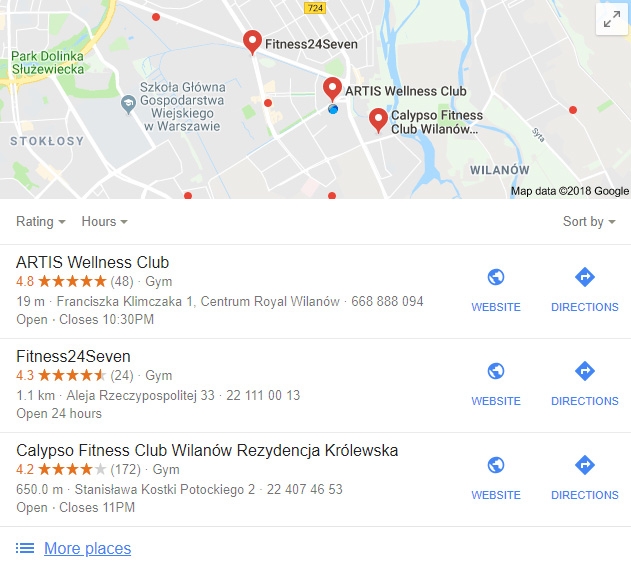
To optimize your website to rank locally, you'll need to:
- use local keywords in your content
- have consistent NAP (name, address and phone number) across your website and citations
- create lots of local citations
- get a Google My Business page
Google My Business
Google is the most widely used search engine in every country except for China, Hong Kong, Japan, Russia, the Czech Republic and South Korea.
In every other country, Google is the most widely used search engine. If you’re in one of the countries not listed above, it’s a good idea to create a Google My Business (GMB) page so that:
- you can appear in local packs
- people can find your address, hours and phone number easily
- potential clients can see your facilities in images
- existing or past users can review your business
A complete Google My Business page will result in your brand showing up in the search engines like this when people search for your brand:
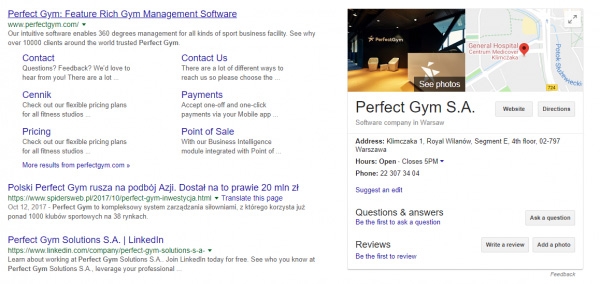
People can easily see your fitness centre’s information on the right-hand side and choose to visit your website to get additional details.
Just be sure that all club information is updated and you choose the category of your business correctly. If you’re managing multiple locations, you can create multiple entries under one account. Remember, getting advertising fitness right might take some time, but once you do, it'll have a huge payoff!
Don't Keywords
Keywords are the terms that people type into search engines to find your club. 72% of the time when users search for a business online they will visit that business within 24 hours.
Coincidentally, if someone already knows about your gym, they will search for your brand name.
Other times, they’ll use local keywords to find your gym or health club like the ones described above.
Whatever the case, be sure to always be as specific as possible when marketing your gym in a local search.
If you have one fitness business in a city, then include the city name on your home page and in your meta description as it is in the example below.

If you have multiple clubs, create a dedicated page for each club on your website with the city name or neighbourhood in the title of that page, as it is below.

Each example has the city in the title and meta description and in the case of the Glasgow gym, it’s included in the URL as well.
You can even go deeper in your descriptions on your websites with multiple locations. An example of this might be:
“Located just off the 405 freeway in the Brentwood neighborhood of West Los Angeles, Gym 123’s members enjoy taking a stroll down to the Santa Monica Pier after their workouts or grabbing a quick coffee at the [Local Shopping Mall Name] before their morning routine.”
This description uses multiple landmarks to identify the gym's surrounding areas, which helps its visibility in the search engines, its overall search marketability and fitness club promotion.
Your descriptions are not only a good opportunity to advertise your fitness business effectively, but also a surefire way to help your search rankings if written well.
Citations
Perhaps one of the most important local SEO factors for fitness club promotion are citations. Citations are online references to your business that don’t necessarily need to link to your website.
All they need to do is have the same NAP (name, address and phone number) as your Google My Business page and Google will automatically know to attribute the reference to your business.
These citations carry authority as the more authoritative the citation is for your business on that site, the more weight it will carry when Google needs to rank your website for searches.
The most common local listing sites are:
- Yelp
- Trip Advisor
- Yellowpages
There are a ton more fitness industry related listings, but some are very location dependent, so make sure you find as many as possible that are locally relevant to your business.
For example, if I have a fitness club in Los Angeles, I will want to look for Los Angeles local listings to list my business in.
Furthermore, these listings often have ratings and reviews and the higher your ratings and reviews are, the more weight they’ll carry in the search engines. In most cases, you can view the ratings from other local listings on the business’ GMB card in the search results.
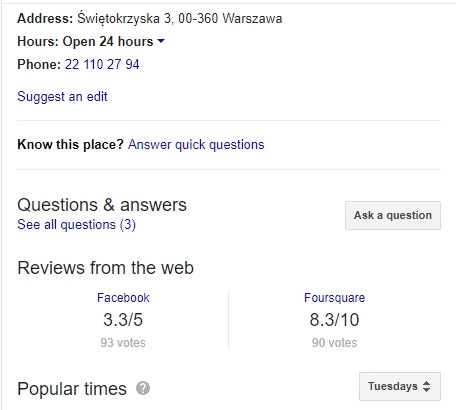
Some citations will cost money, but if they’re from reputable local listing sites, they are worth it.
3. Track Your Club's Fitness Marketing Campaigns
As we’ve noted above, a lot of client acquisition happens online. When you’re trying to drive users to your website or client portal, it’s important to know which marketing channels are the most effective for your gym or health club.
That’s why you should always set up goal tracking in Google Analytics to monitor the success of each fitness marketing campaign. You may need some assistance from a developer to do this, but it’s definitely worth it to know which campaigns are bringing you the most leads.
Once you set up goals, you’ll need to attach UTM tags to each link you send out on social media, newsletters, etc. You can build UTM tags here by simply naming each campaign, the medium, and the source.
Once you send out the link and someone clicks it and reaches the goal you’ve set up on your website, it will be reflected in Google Analytics.
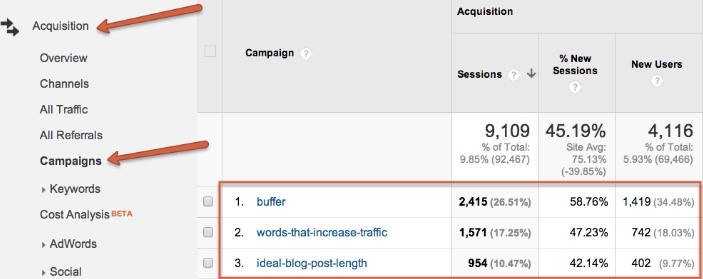
This will come in handy whenever you send a link out or come up with any other digital marketing campaign ideas for your gym and want to know what the return-on-investment (ROI) is.
If you want to take it a step further, you can integrate your Google Analytics tracking with a fitness CRM in your club's management system that you know from the beginning which leads have become paying club members.

Even if most fitness club marketing results are handled in-person, it will always be of benefit for fitness clubs to understand the success or failures of any digital marketing campaign when assessing how to spend your gym’s marketing budget next time around.
Data-Driven Member Acquisition
The best way to leverage your data to acquire new members is to understand who your best performing members are.
With PerfectGym's business intelligence module powered by machine learning, you can understand which members are likely to leave your club and which members are likely to stay.
The likelihood of a member leaving is shown as a percentage. The higher the percentage, the more likely they are to leave and the lower means they're more likely to stay.
However, when you have members that are less likely to leave, then you know they're your best performing members and you should acquire more like them.
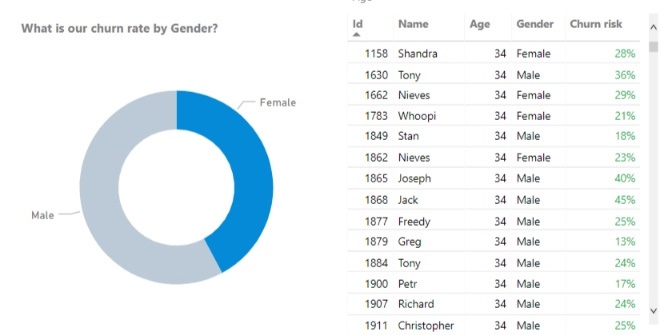
What you can do is export the data of your best members and then use their email addresses in lookalike fitness marketing promotion on Facebook or Google Display Network.
Not only will you get members that are similar to your best members, but you'll have ones that are more likely to convert and have longer-tenured memberships.
4. Written Fitness Content Marketing is a Must!
While it’s always a good practice for gyms to do content marketing, you should be aware that in the world of search engine marketing for fitness brands and the fitness industry, fitness-related keywords are extremely competitive.
And they should be. Ranking for a keyword like “how to do a pushup” isn’t going to bring you a lot of targeted results as people coming to your website for that keyword 99% of the time won’t be local users.
However, ranking for keywords that are fitness and local-oriented, can help you.
For example, locally-oriented content as listed below has local targeting built into it:
- best outdoor workouts in [city name]
- best hikes in [city name]
- where to buy cheap supplements in [city name]
Simply create a fitness blog and start writing about fitness in your area.
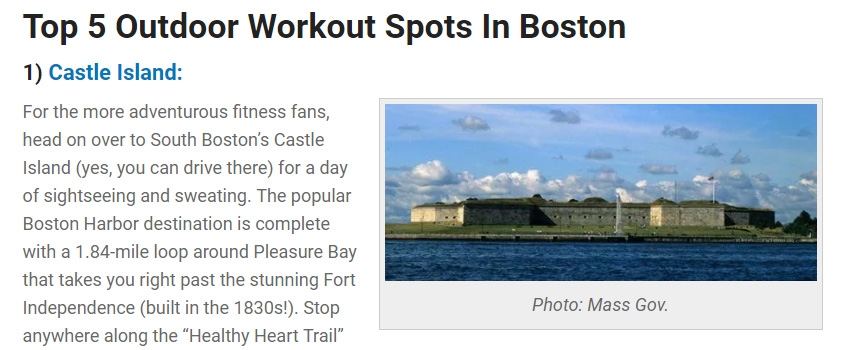
These results will bring website visitors that use your city’s name in the searches, meaning they are more than likely residing there.
You can also craft content that is more tailored to widespread audiences if you’re intention is to market it on different channels other than search engines.
You can share it on your social media accounts, local forums, or send it out to churned clients who may need inspiration to get back into the gym.
5. Video Content Marketing to Stay Relevant
With social media outlets all promoting video content, it’s a definite no-brainer to join the frenzy to promote your fitness facility.
Video content allows prospective clients to see what workouts are like in your gym, your club’s facilities and how much fun your clients are having!
You can use things like Facebook’s live stream to advertise your gym and show people who have liked your page what’s going on in your club in real-time.
Instagram is also a great fitness marketing strategy for promoting your gym’s video content. It can help when people search via location and/or hashtags to find workout plans, classes or personal trainers in their areas.
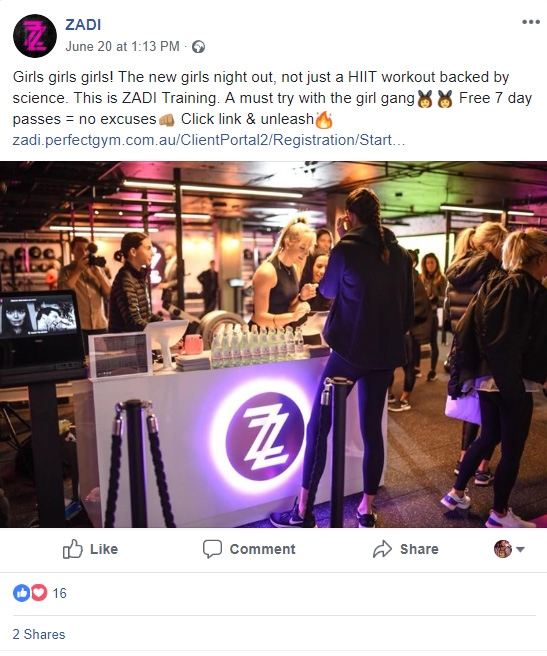
It’s a great way to engage with your existing club members and advertise your gym to prospective clients browsing through social media.
6. Post on Social Media to Engage More Members
After looking at over 100 fitness brands’ social media profiles, we found that 82% of them post daily on either Facebook or Instagram. And that’s no accident.
Gym social media marketing campaign has been around since the social media platforms became universally used, as they have the added benefits of engaging your current clients and showing potential customers what workouts and life is like in your club in general.
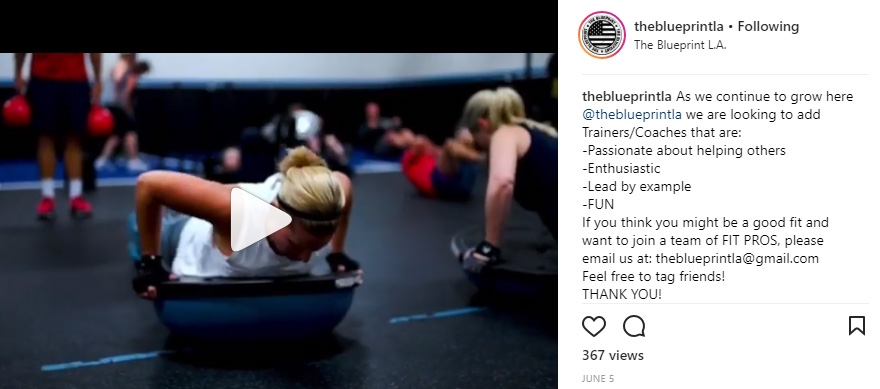
Social media has become one of the most widely used channels embedded into any fitness marketing strategy.
Just remember to attach UTM tags if you want to measure how many people specifically signed up for your club from any post or campaign you market on social media.
If you want to streamline your social media posts, you can use a free tool like buffer to schedule posts ahead of time, cross-post between different social media platforms, measure the engagement and track your results.

It’s a great tool for keeping your gym’s social media marketing on track and up-to-date.
7. Start a Referral Program and Let Existing Members do the Work for You
Sometimes the best in gym advertising can be your members. If you provide excellent services and facilities and incentivize your members, you can create a gym referral program to get them to invite their family and friends.
When your members refer a friend or family member to your gym and that new prospect becomes a member, you can reward them both so that they’re both more likely to keep referring people.
All at little to no cost!
There are several ways to implement a referral program:
- Have it built into your club’s mobile app
- Referral cards
- Emails
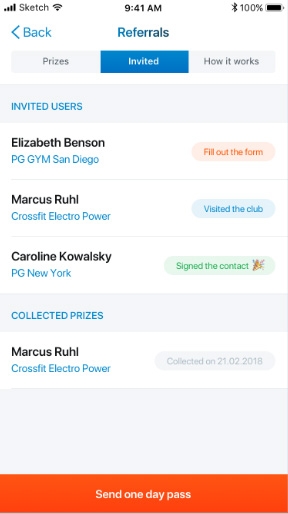
The most important part about starting a referral program for your club is making sure your members are aware you have one.
You can post on social media, send them emails, put up posters in your club or, as mentioned above, have a module in your mobile app.
The second most important aspect is to ensure that claiming ownership of a referral for your members is easy enough. This is why I would suggest doing it digitally with your app so that when a prospect or lead uses a guest pass, the referral number can be tied to your existing member.
Then you can reward your member (and the prospect if they become a new client) with whatever it is you chose to incentivize them with.
Club referral programs should be a universal aspect of any fitness marketing campaign for clubs.
8. Gym Promotions to Attract New Members
“New year, new me”. Probably the most over-hyped New Year’s resolution is always to get fit.
Gyms typical fitness marketing strategy response to this fitness related new years resolution with massive membership discounts for people who sign up within a given amount of time after the new year begins.
There’s never really a bad time to offer a promotion, but make sure you take advantage of the “scarcity” factor, meaning that people are more inclined to purchase something if it’s only available for a limited time.
Thus, it’s important not to let your fitness marketing promotion run year-round otherwise the value of that scarcity is heavily diminished and people will begin to associate the discounted price as the normal one.
But how do reach a new audience to make them aware of your club’s promotion? A few good tips for marketing your gym’s promotions are to:
- Add extra incentives for your members to refer friends
- Do some paid digital marketing campaigns on Facebook or Google
- Print advertising
- Billboards
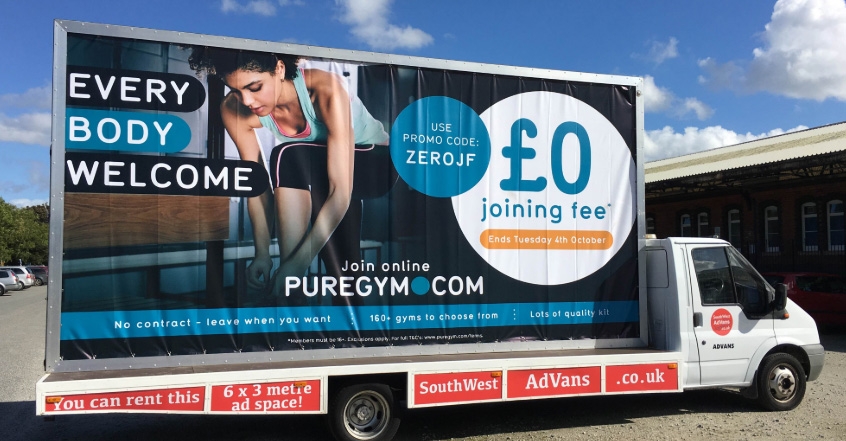
The problem with the last two is that they are difficult to measure, so ensure that your front desk person or sales representatives are asking new leads how they specifically heard about the promotion.
However, billboards and print advertising can be especially helpful in cities with a lot of fitness clubs as there is less space on digital channels for every club to stand out.
Clubs that operate in cities that don’t have a lot of fitness facilities should try and be as present as possible in digital marketing channels like Google and social media.
9. Affiliate Marketing for Fitness Facilities
If you're still wondering how to get more gym members affiliate marketing is the answer.
Affiliate marketing is when you set up a process for people outside of your club to refer other people who might be interested in a gym membership to join your gym.
It can be a fantastic marketing strategy for your gym as a way to get clients in your door from people they respect. If you have a client portal set up, you can take payments for new memberships while you sleep.
Passive income rules!
Even in the most remote locations, there are a few different businesses that can refer their clients to your club such as:
- Doctors
- Physical therapists
- Supplement providers
- Fitness apparel stores
- Personal Trainers
You can incentivize these businesses by offering their company heavily discounted memberships or just a flat fee for every member they refer, like 20% of their contract value.
For personal trainers, you can offer them a place to train their clients commission-free as long the members have an active membership there. Then the clients will associate their trainers with your club, which helps you retain them for longer periods.
9. Send out a Weekly Newsletter
You may think that gym newsletters are only for existing clients. That’s wrong.
Yes, they should contain up-to-date club news, but they can also be used to market to churned members or old leads that didn’t buy a membership.
Your churned members may have cancelled their membership, but most often they still stay subscribed to your emails which means you can still reach them with club updates, promotions and fitness advice.
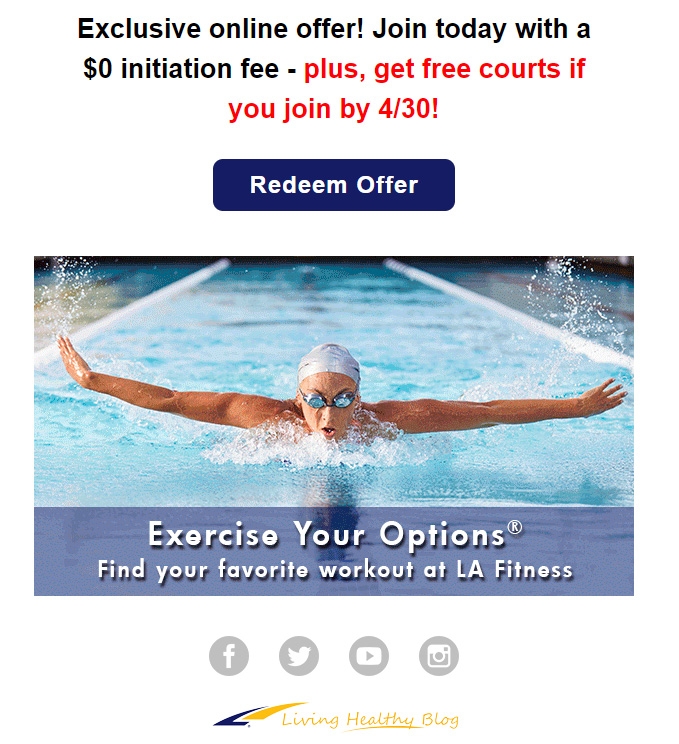
For example, you can consistently feature a “Member of the Week” that highlights their success in reaching their goals at the gym. This kind of acknowledgement rewards those members that have worked so hard to reach their goals while also encouraging churned members to get back into the gym.
Either way, you’ll be able to pique the interest of current and former members. Everybody wins!
Just remember to leave an unsubscribe link so that you’re not infringing on your members’ privacy. However, if they don’t opt out you can continue to email them as long as you have consent.
10. Remarketing to Increase Visibility
Remarketing is what happens when someone visits your website and doesn’t make a purchase so you position ads elsewhere on the internet hoping that they will see them and come back to your website to make a purchase.
In fitness remarketing, you have a much lower rate of finding out if someone was converted because of your remarketing ads because they will more often than not come into your facility to sign-up.
However, it doesn’t mean that it doesn’t have its merits. Website visitors that are remarketed to are 70% more likely to convert.
You can create remarketing ads for people who visited your pricing page with content that offers a promotion only redeemable online.
Then they can reap the benefits of a discounted membership and you can measure the success of these campaigns more easily.
Typical remarketing platforms include:
- Google Display Network
To initiate an effective remarketing campaign, you’ll first need to drive people to your website or client portal. From there you can track which pages they visit so you better understand their intentions and display ads to them based on what pages they viewed.
For example, let's say you set up Facebook Pixel. If someone visits your website and goes to a section about Zumba classes, you can choose to display an ad about discounted Zumba classes at your club to appear in their news feed next time they’re on the platform. They can also view Facebook ads with your fitness clubs current promotion.

Then you can link to your sign-up page so they can register. Again, remember to use UTM tags when performing remarketing campaigns so you can measure your success when people click on your gym's ad.
11. Host an Event at Your Fitness Facility
With all the success, goodwill and healthy lifestyle, your club is helping members to enjoy, you should celebrate!
Host a social event at your club or at another venue and tell your members to invite their friends. It’s a good way to network and meet some of their peers so they can experience the positve atmosphere that your staff and members enjoy.
Good gym marketing ideas for events are:
- Club anniversaries
- Membership milestones like reaching 1,000 club members or more
- Holiday events
- Staff birthdays
Whatever the occasion is, a healthy mind and body are always a cause for celebration! It just so happens that you can make some new friends and potentially some new clients from it.
Market your gym as a place for transformation, community and positive change and your members will be your strongest marketers.
Concluding Thoughts
Fitness marketing strategies are as numerous as they are nuanced. You can choose to do a few different ones or all, but the most important thing to remember is to always measure the success of each campaign in your club management software.
Very often fitness clubs will market to anyone and everyone without taking the time to see how each campaign impacts their budget positively or negatively.
Set up systematic checkpoints digitally and with your staff to always be asking: “how did you hear about us?”.
It will pay off in the end.